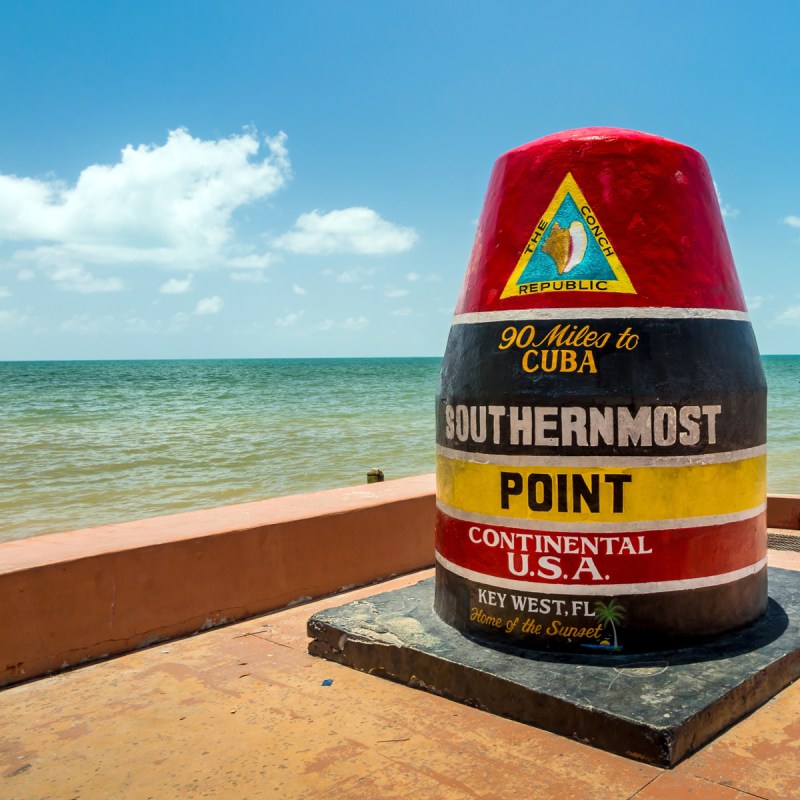
Florida is great for finding outdoors, back-to-nature adventures. Despite the explosive growth in recent years, there are still plenty of wilderness areas to explore. None more so than in the Florida Keys … from Key Largo to Key West eco-travel adventures abound. The Keys are also known as the Conch Republic because, in a not-so-serious attempt, they seceded from the United States for a couple of days in 1982. There is even a flag.
Videos by TravelAwaits
Naturally, in an area surrounded by water, adventures out on the water are available all along the Keys. Kayaking, stand-up paddle boards, fishing charters, and kayak fishing, diving on the reefs, are all readily available in the Keys. If you’re a cyclist there is the Overseas Heritage bike trail, a paved trail that runs over 90 miles, following the route of the old rail line that connected Miami to Key West.
Everything in the Keys is measured by mile markers along U.S. Highway 1, so follow along as we take you from Mile Marker 106 in Key Largo, to Mile Marker 0 in Key West.

The Upper Keys
1. Mile Marker 103 — Get Outdoors In Key Largo
John Pennekamp Coral Reef State Park is located in Key Largo. Here you can dive the offshore reef system. There are outfitters for both SCUBA and snorkel divers, and they take you to the best spots along the reef, which is located in 20-30 feet of water in most places.
Working with Florida Bay Outfitters you can rent kayaks and stand-up paddle boards. The waters around the park are usually pretty calm, protected by the reef.
There is also a campground at Pennekamp for tents and RVs. Wear mosquito repellent and beware of aggressive food stealing raccoons in the campground.
On the other side of the road is Florida Bay, with shallow and protected waters. Kayak fishing is popular in the bay. The mangroves provide scenic kayak and paddle board trips in the waters of the Everglades.
2. Mile Marker 91 — Head To Tavernier For Two-Wheeled Adventures
Key Largo Bike and Adventure Tours can set you up with bike tour packages. It offers anything from one day to multi-day tours of the Keys. Casual riders can stick to the Heritage Trail for a scenic day trip, separated from traffic. More experienced riders can choose to ride on U.S. 1, some going as far as Key West. It offers a Keys Bike Guide that gives you information about the different bike routes and tour packages.

3. Mile Marker 82 — Angle In Islamorada
Islamorada bills itself as the “sport fishing capital of the world,” with a large charter fleet to take anglers on deep sea fishing trips in the Atlantic. Local restaurants are happy to prepare your catch of the day.
There are several small state parks in Islamorada. The Windley Key Fossil Reef Geological Park is actually an abandoned quarry, which was used to mine rock for some of the bridges on the Overseas Railroad. The Lignumvitae Key Botanical State Park has tropical forest and hiking trails. Here you will find the monument to those who died in the catastrophic 1935 hurricane.
4. Mile Marker 78 — Kayak To History
Indian Key Historic Park is located just offshore on the Atlantic side of the highway. It’s a short kayak paddle to see what remains of a once-thriving village. The main business on Indian Key was “wrecking,” the salvaging of boats and cargos that ran aground on the reefs. You can walk the streets and see the foundations of what used to be homes and businesses. The island was abandoned after the hurricane of 1935.
5. Mile Marker 68 — Stay Awhile At Long Key
Long Key State Park offers camping, hiking, and paddling. The park was originally a luxury fish camp that was a popular stop for the Overseas Railroad. The fish camp was an attraction to the rich and famous who stopped to try their luck at saltwater fishing. The camp and the railroad were washed away in the 1935 hurricane. The state park opened in 1969.

The Middle Keys (A Good Resting Point)
6. Mile Marker 61 — Splash Around On Duck Key
Duck Key is home to Hawk’s Cay Resort, a good midway point along the Keys highway. The resort offers watersports like kayaking and paddle boarding. There are boat excursions to the reef and sandbar just offshore in the Atlantic. You can also sign up for saltwater fishing trips.
7. Mile Marker 56 — Head Into The Wilderness At Curry Hammock
Curry Hammock State Park is on an uninhabited island on the Atlantic side of U.S. 1. There are mangrove forests, hardwood hammocks, swamps, and seagrass beds… a relatively unspoiled ecosystem. The park has a campground, beach, and nature trails. There is a kayak trail that leads paddlers through the mangroves and circumnavigates the entire island.

8. Mile Marker 50 — Maximize Marathon, The Keys’ Midpoint
Sombrero Beach is arguably the best sand beach in the Keys. The Keys are mainly a coral rock formation, and not known for sandy beaches. Sombrero is popular with locals, and out-of-town visitors have to know how to find it because it isn’t widely publicized.
Marathon is another spot for finding deep sea fishing charters. You can also try your luck at kayak fishing, especially under Seven Mile Bridge as fish swim with the tides washing in and out between the Atlantic and Florida Bay.
Seven Mile Bridge was originally built in the early 1900s as a long railroad trestle spanning the widest channel in the Keys. The railroad was destroyed by the 1935 hurricane, and work to replace it with the highway was started under the Civilian Conservation Corp of the Great Depression era. Most of the workers were unemployed veterans of World War 1, and many perished in the hurricane. The modern bridge opened in 1982.

9. Mile Marker 37 — Noted Sunrises And Sunsets
Bahia Honda State Park is located a short distance south of Seven Mile Bridge. It has two campgrounds, one primarily for RVs, the other for tent campers. There is a long, gently sloping beach which is great for families with small children. The water is shallow and protected by the offshore reef. You will also find the remnants of the railroad bridge that spans the deepest channel in the Keys. Park visitors can walk the bridge to observe beautiful sunrises and sunsets.
10. Mile Marker 31 — Where Key Deer Roam
Big Pine Key is home to the endangered diminutive Key Deer, a species no bigger than a greyhound dog and found only here. The highway has high fencing to keep deer off the road, but you can easily find the deer grazing along neighborhood roads and streets off the main highway.
This area of the Keys has some of the best kayaking trails. There are lots of small islands and mangrove forests on the bayside of the island. The water here is very shallow in spots so you have to be aware of the tide schedules to avoid being stranded and having to drag your kayak to a deeper channel. I recommend the guide book, Kayaking The Keys by Kathleen Patton, University Press, available from Amazon.
South of Big Pine Key there are a number of smaller Keys, some inhabited, some not. The kayaking in these areas is outstanding. Hire a guide and try fishing on the bayside for snook, the popular game fish.

The Lower Keys Mean Party Time
11. Mile Marker 9 — Restricted Access
Boca Chica Key is home to the Key West Naval Air Station, which is a prime air-to-air combat training post. The Navy has had a station on the Key going back to the 1820s when the primary mission was to stop piracy. Much of the Key is restricted access but there is a little-used highway on the Atlantic side of the Key that makes for great bicycling.
12. Mile Marker 0 — Funky Key West
At last, you have arrived! Mile Marker 0 is the place for your ubiquitous selfie pictures in Key West. You will always find a crowd of people angling to get in the picture.
Duval Street is the main street through Key West, lined with bars, restaurants, and gift shops. Here you will find Sloppy Joe’s, Ernest Hemingway’s old haunt. It seems every bar on the street has a guitar-playing singer crooning Jimmy Buffett songs.
Mallory Square is the place to go for sunsets, but be warned, it gets very crowded and has become overly touristy. You will find panhandling musicians, jugglers, stilt walkers, and other exotic entertainment. The Square even has its own website. The Shops At Mallory Square include boutiques and art galleries. A lot has changed since the hippy hangout days of the 70s.

Dry Tortugas National Park
Just because you reached Mile Marker 0 doesn’t mean your adventures are over. Hop aboard the Yankee Freedom ferry in Key West and take the 3-hour boat ride to Fort Jefferson and the Dry Tortugas National Park.
The Dry Tortugas is a chain of seven small islands about 70 miles west of Key West. It’s home to Fort Jefferson, built as a southern waters defense fort in the 1840s. The fort was never used for defense by the military and later became a federal prison where Samuel Mudd, the doctor who treated John Wilkes Booth, was jailed.
Most people visit for a day trip, giving them a scant few hours to explore the fort and Garden Key, the island the fort is built on. But there is another option. Camping is permitted on the island. It is very primitive, with no water, no electricity. You have to pack in all the food, water, and camping supplies that you need.
Even if you’re just daytripping, bring plenty of water. There is none on the island. That’s why they are called the DRY Tortugas.
Pro Tip
The Florida Keys are America’s tropical island getaway. The best way to travel there is driving on U.S. 1 from the Upper Keys to Key West. Don’t try to make the trip in one day. Stop often, enjoy all the Keys has to offer. My recommendation is, if you have a week’s vacation, spend 2 days in each of the Upper and Middle Keys, and 3 days in Key West, including a day trip to the Dry Tortugas.
There are many adventures waiting for visitors to the Florida Keys:
